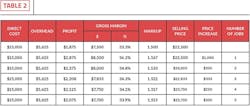Death by Discount
One of the biggest mistakes remodelers can make is to discount their price. Sometimes they do it to match a competitor’s bid or because they “need the work.” Sometimes the owner asks for a discount for “winter work” when, in fact, it actually costs more to build in winter. Remodelers hand out discounts of 2%, 3%, 5% like candy, without ever realizing the true cost. After all, they reason, how much harm can come from such a small discount? Let’s do the math and find out.
Imagine your company has bid on a small bathroom remodel that’s similar to work you’ve done before. You know your costs cold, and you’ve always earned a solid 33% margin. When you give the client your price of $22,500, they explain that they have a competing price of $21,500. They hope you can match it because they would really like to work with you. You do a quick calculation in your head and realize that a $1,000 discount is less than 5% (4.4% to be exact). Work is a little slow at the moment and you want to keep the crew busy until things pick up. Plus, you think to yourself, when it starts to get busy, you’ll have no trouble making up for the discount. So you agree to cut $1,000 from your price.
Here’s what the numbers look like:
Assuming the work goes as planned, the $1,000 discount on this hypothetical remodeling job reduces gross margin by 3.1%—not so bad, until you realize that while the client saved almost 5% on the selling price, the contractor lost 10 times that much in profit (53.3%).
What Did You Discount?
Let’s assume the job runs like clockwork (just like always, right?). Your costs are exactly as estimated, so no savings there, and your overhead doesn’t change. That leaves only your profit to take the hit—and quite a hit it is: A 4.4% discount on the selling price is a 53.3% discount in profit.
Let that sink in: When you gave away that $1,000, you cut your profit by more than half. And remember, we’ve assumed that the project proceeds as planned with no hiccups that add cost beyond what you estimated.
Robbing Peter to Pay Paul
It gets worse. Recall that part of your reasoning when you decided to give the discount was that you could make it up on future work. Let’s take a closer look at a couple of ways that could actually happen.
Easiest and quickest would be to make up the entire $1,000 on one job. It couldn’t be a really small job, though, because the $1,000 surcharge would price you out of the market. You could easily add a $1,000 surcharge to a big job, but there is no guarantee you’ll get a big job anytime soon. That leaves the option of hiding a couple of hundred dollars in a series of smaller jobs until you’ve recouped the $1,000. But there are problems with that approach, too.
The top row shows the original quote, before the $1,000 discount. The other five rows show examples of the amount a contractor would have to charge clients for the same work to make up for the discount by adding a surcharge to as few as one or as many as five future jobs.
Let’s assume that bathroom remodeling is your bread-and-butter, and the job you discounted is about average for your company. The table above shows the effects of adding a surcharge—either $1,000 to a single average bathroom remodel or $200 to a series of five average jobs .
If you inflate your price by $1,000, you might not get the work. Remember, you had trouble selling the original job at $22,500. What makes you think you can sell a similar job for $23,500? This is especially problematic if you’re selling a referral from the original customer, because you now have a reputation for discounting your price.
What about hiding $200 in the next five jobs? You still have the pricing problem and the reputation for discounting, but it’s a small amount and it could work. But that also stretches out the recovery plan over several months.
And let’s be honest: “Hiding” the $1,000 is exactly what you’re doing. You are overcharging several future customers to make up for undercharging a single past customer. You could argue that this isn’t any different from raising your prices for any other reason, but is that really the way you want to do business?
Don’t forget that this example is for just a 4.4% discount. Many remodelers routinely cut their price by twice that or more. And if the discount is on a larger job, the percentage may still be small but the dollar amount is larger, making it more difficult to recover by inflating the price of smaller jobs.
No matter how you look at it, discounts are bad for business. If you’re going to raise prices, do it for the right reasons. You can adjust your price in exchange for a change in the scope of work or the material specs, but don’t do it just to get the work. The cost of the discount is too high.


